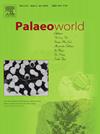Pseudoconocardium licharewi Zavodowsky, 1960, the latest representative of the extinct class Rostroconchia (Mollusca)
IF 1.7
3区 地球科学
Q2 PALEONTOLOGY
引用次数: 0
Abstract
Rostroconchs are one of the “minor classes” of the phylum Mollusca. They were especially diverse in Early and Middle Palaeozoic, but by the end of Late Palaeozoic the group’s diversity had sharply declined. This study shows that rostroconchs completely disappeared from the fossil record before the great end-Permian mass extinction event. The paper offers the first review of all Permian rostroconch localities in Northeast Russia and discusses their possible depositional settings. All records are precisely referenced to the zonal bivalve scale of Northeast Asia, calibrated and correlated with the International Chronostratigraphic Chart using SHRIMP and ID-TIMS dating, taking into account δ13Corg chemostratigraphic data. All Permian rostroconchs in this region are represented by different forms of preservation of the same species — Pseudoconocardium licharewi Zavodowsky, 1960 and are distributed in the interval: the second half of the Artinskian — the lower part of the Changhsingian. Thus, the species in question is the latest known representative of rostroconch in the world. The type series of Pseudoconocardium licharewi, type species of the genus Pseudoconocardium Zavodowsky, 1960, as well as specimens housed in the collection of the Borissiak Paleontological Institute of the Russian Academy of Sciences, are examined. Based on a detailed study of shell morphology, an emended generic diagnosis and a new description are presented here. It is also shown that the genus Pseudoconocardium is monotypic.
Pseudoconocardium licharewi Zavodowsky, 1960,已灭绝的Rostroconchia(软体动物)纲的最新代表
螺螺是软体动物门的“小纲”之一。它们在早古生代和中古生代尤其多样化,但到晚古生代末期,该群体的多样性急剧下降。这项研究表明,在二叠纪末大灭绝事件之前,螺类完全从化石记录中消失了。本文首次回顾了俄罗斯东北部所有二叠纪逆海螺的分布,并讨论了它们可能的沉积背景。所有记录均精确参照东北亚双壳类带标度,并结合δ13Corg化学地层资料,利用SHRIMP和ID-TIMS定年与《国际年代地层图》进行校正和对比。该地区所有二叠纪螺类均以同一物种(Pseudoconocardium licharewi Zavodowsky, 1960)的不同保存形式为代表,分布于阿丁斯基纪下半期-长兴纪下半期区间。因此,该物种是世界上已知的最新的螺类代表。本文对1960年的Pseudoconocardium Zavodowsky属模式种Pseudoconocardium licharewi类型系列以及俄罗斯科学院Borissiak古生物研究所收藏的标本进行了研究。在详细研究壳形态的基础上,提出了一种修订的一般诊断和新的描述。结果还表明,假concardium属是单型的。
本文章由计算机程序翻译,如有差异,请以英文原文为准。
求助全文
约1分钟内获得全文
求助全文
来源期刊

Palaeoworld
PALEONTOLOGY-
CiteScore
4.00
自引率
5.90%
发文量
95
期刊介绍:
Palaeoworld is a peer-reviewed quarterly journal dedicated to the study of past life and its environment. We encourage submission of original manuscripts on all aspects of palaeontology and stratigraphy, comparisons of regional and global data in time and space, and results generated by interdisciplinary investigations in related fields. Some issues will be devoted entirely to a special theme whereas others will be composed of contributed articles. Palaeoworld is dedicated to serving a broad spectrum of geoscientists and palaeobiologists as well as serving as a resource for students in fields as diverse as palaeobiology, evolutionary biology, taxonomy and phylogeny, geobiology, historical geology, and palaeoenvironment.
Palaeoworld publishes original articles in the following areas:
•Phylogeny and taxonomic studies of all fossil groups
•Biostratigraphy, chemostratigraphy, chronostratigraphy
•Palaeoecology, palaeoenvironment and global changes throughout Earth history
•Tempo and mode of biological evolution
•Biological events in Earth history (e.g., extinctions, radiations)
•Ecosystem evolution
•Geobiology and molecular palaeobiology
•Palaeontological and stratigraphic methods
•Interdisciplinary studies focusing on fossils and strata
 求助内容:
求助内容: 应助结果提醒方式:
应助结果提醒方式:


